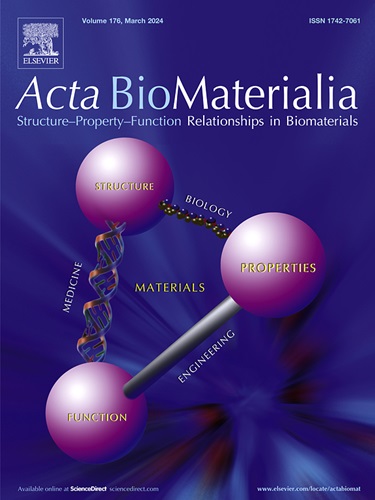Targeted CRISPR regulation of ZNF865 enhances stem cell cartilage deposition, tissue maturation rates, and mechanical properties in engineered intervertebral discs
IF 9.4
1区 医学
Q1 ENGINEERING, BIOMEDICAL
引用次数: 0
Abstract
Cell and tissue engineering based approaches have garnered significant interest for treating intervertebral disc degeneration and associated low back pain due to the substantial limitations of currently available clinical treatments. Herein we present a clustered regularly interspaced short palindromic repeats (CRISPR)-guided gene modulation strategy to improve the therapeutic potential of cell and tissue engineering therapies for treating intervertebral disc disease. Recently, we discovered a zinc finger (ZNF) protein, ZNF865 (BLST), which is associated with no in-depth publications and has not been functionally characterized. Utilizing CRISPR-guided gene modulation, we show that ZNF865 regulates cell cycle progression and protein processing. As a result, regulating this gene acts as a primary titratable regulator of cell activity. We also demonstrate that targeted ZNF865 regulation can enhance protein production and fibrocartilage-like matrix deposition in human adipose-derived stem cells (hASCs). Furthermore, we demonstrate CRISPR-engineered hASCs ability to increase GAG and collagen II matrix deposition in human-size tissue-engineered discs by 8.5-fold and 88.6-fold, respectively, while not increasing collagen X expression compared to naive hASCs dosed with growth factors. With this increased tissue deposition, we observe significant improvements in compressive mechanical properties, generating a stiffer and more robust tissue. Overall, we present novel biology on ZNF865 and display the power of CRISPR-cell engineering to enhance strategies treating musculoskeletal disease.
Statement of significance
This work reports on a novel gene, ZNF865 (also known as BLST), that when regulated with CRISPRa, improves cartilagenous tissue deposition in human sized tissue engineering constructs. Producing tissue engineering constructs at human scale has proven difficult, and this strategy presents a broadly applicable tool to enhance a cells ability to produce tissue at these scales, as we saw an ∼8–88 fold increase in tissue deposition and significantly improved biomechanics in large tissue engineered intervertebral disc compared to traditional growth factor differentiation methods. Additionally, this work begins to elucidate the biology of this novel zinc finger protein, which appears to be critical in regulating cell function and activity.

对ZNF865的靶向CRISPR调控可增强工程椎间盘中干细胞软骨沉积、组织成熟率和机械性能。
由于目前可用的临床疗法存在很大局限性,基于细胞和组织工程的方法在治疗椎间盘变性和相关腰背痛方面引起了极大的兴趣。在此,我们提出了一种在簇状规则间隔短回文重复序列(CRISPR)引导下的基因调控策略,以提高细胞和组织工程疗法治疗椎间盘疾病的潜力。最近,我们发现了一种锌指(ZNF)蛋白 ZNF865 (BLST),该蛋白未发表过相关的深度文章,也没有功能特征。利用 CRISPR 引导的基因调控,我们发现 ZNF865 可调控细胞周期进展和蛋白质加工。因此,调节该基因可作为细胞活性的主要滴定调节因子。我们还证明,有针对性的 ZNF865 调控可以提高人脂肪来源干细胞(hASCs)的蛋白质产量和纤维软骨样基质沉积。此外,我们还证明了 CRISPR 工程化的 hASCs 能够增加 GAG 和胶原蛋白 II 在人体大小的组织工程化椎间盘中的基质沉积,分别增加了 8.5 倍和 88.6 倍,而与使用生长因子的天真 hASCs 相比,胶原蛋白 X 的表达并没有增加。随着组织沉积的增加,我们观察到抗压机械性能有了显著改善,形成了更坚硬、更牢固的组织。总之,我们介绍了 ZNF865 的新生物学特性,并展示了 CRISPR 细胞工程在加强肌肉骨骼疾病治疗策略方面的威力。意义说明:这项研究报告了一种新型基因 ZNF865(又称 BLST),当使用 CRISPRa 进行调控时,它能改善人体大小的组织工程构建物中软骨组织的沉积。与传统的生长因子分化方法相比,我们发现在大型组织工程椎间盘中,组织沉积增加了~8-88 倍,生物力学也得到了显著改善。此外,这项工作还开始阐明这种新型锌指蛋白的生物学特性,它似乎对调节细胞功能和活性至关重要。
本文章由计算机程序翻译,如有差异,请以英文原文为准。
求助全文
约1分钟内获得全文
求助全文
来源期刊

Acta Biomaterialia
工程技术-材料科学:生物材料
CiteScore
16.80
自引率
3.10%
发文量
776
审稿时长
30 days
期刊介绍:
Acta Biomaterialia is a monthly peer-reviewed scientific journal published by Elsevier. The journal was established in January 2005. The editor-in-chief is W.R. Wagner (University of Pittsburgh). The journal covers research in biomaterials science, including the interrelationship of biomaterial structure and function from macroscale to nanoscale. Topical coverage includes biomedical and biocompatible materials.
 求助内容:
求助内容: 应助结果提醒方式:
应助结果提醒方式:


